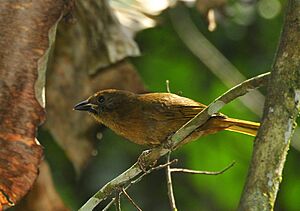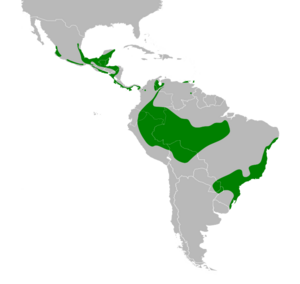Red-crowned ant tanager facts for kids
Quick facts for kids Red-crowned ant tanager |
|
|---|---|
 |
|
| Male at Bertioga, São Paulo State, Brazil | |
 |
|
| Female at Miracatu, São Paulo State, Brazil | |
| Conservation status | |
| Scientific classification | |
| Genus: |
Habia (bird)
|
| Species: |
rubica
|
 |
|
The red-crowned ant tanager (scientific name: Habia rubica) is a medium-sized bird found in warm, tropical parts of the Americas. Even though it's called an "ant-tanager," it's actually more closely related to cardinals than to tanagers. This bird is known for its bright colors and its interesting ways of finding food.
Contents
How Scientists Classify This Bird
Scientists give every living thing a special name. This helps them organize and understand nature. The red-crowned ant tanager was first described in 1817 by a French scientist named Louis Pierre Vieillot. He gave it the name Saltator rubicus. The word rubicus means "reddish" in an old language called Medieval Latin.
Today, this bird is placed in a group called Habia. This group was created in 1840 by Edward Blyth. There are 17 different types, or subspecies, of the red-crowned ant tanager. They live in different areas, from Mexico all the way down to Argentina.
- H. r. holobrunnea – east Mexico
- H. r. rosea – southwest Mexico
- H. r. affinis – south Oaxaca (south Mexico)
- H. r. nelsoni – Yucatán Peninsula (southeast Mexico)
- H. r. rubicoides – central south, south Mexico to Honduras and El Salvador
- H. r. vinacea – west Costa Rica and Panama
- H. r. alfaroana – northwest Costa Rica
- H. r. perijana – north Colombia and northwest Venezuela
- H. r. coccinea – central north Colombia and west Venezuela
- H. r. crissalis – northeast Venezuela
- H. r. rubra – Trinidad
- H. r. mesopotamia – east Venezuela
- H. r. rhodinolaema – east Colombia, east Ecuador, northeast Peru and northwest Brazil
- H. r. peruviana – east Peru, west Brazil and north Bolivia
- H. r. hesterna – central Brazil
- H. r. bahiae – east Brazil
- H. r. rubica – east Paraguay, southeast Brazil and northeast Argentina
What the Red-Crowned Ant Tanager Looks Like
The red-crowned ant tanager is about 17 to 19 centimeters (7 to 7.5 inches) long. Males weigh between 28 and 43 grams, while females are a bit lighter, weighing 23 to 37 grams.
The adult male bird is a dull reddish-brown color. Its throat and chest are a brighter red. When the male gets excited, it can raise a bright scarlet stripe on its head. This stripe has black edges.
Female birds look different. They are yellowish-brown. Their throat is yellow, and they have a yellow-buff stripe on their head.
This bird is usually shy, but it can be quite noisy. Its call sounds like a rattle, followed by a musical "pee-pee-pee."
Where They Live
Red-crowned ant tanagers live in many places. Their home range stretches from Mexico in the north, all the way south to Paraguay and northern Argentina. They also live on the island of Trinidad.
These birds are common in their wide range. Scientists do not consider them to be in danger. They like to live in the middle parts of forests. They also enjoy areas with lots of ferns, shrubs, and other small plants.
Behavior and Habits
What They Eat
Red-crowned ant tanagers are often seen in pairs or small family groups. They mainly eat arthropods, which are creatures like insects and spiders. But they also enjoy eating berries.
In some areas, like Central America and Trinidad, these birds often follow army ants. Army ants march in large groups and stir up other small creatures. The ant-tanagers then snatch up the insects that are trying to escape the ants.
In Brazil, they sometimes join groups of different bird species that feed together. They also follow South American coatis (a type of mammal) when the coatis are looking for food. The birds eat insects that the coatis scare out of hiding. This is a type of relationship called commensalism. It means the birds benefit from the ants or coatis, but the ants or coatis are not harmed.
How They Reproduce
The female red-crowned ant tanager builds a shallow, cup-shaped nest. She usually places it in a young tree or a tree fern near a stream.
A normal clutch of eggs is two or three. The eggs are white with brown spots. The female bird sits on the eggs for 13 to 14 days until they hatch. Both parents help feed the baby birds. The young birds leave the nest when they are about ten days old. At this age, they cannot fly yet. Instead, they hop around and hide in thick plants to stay safe.


